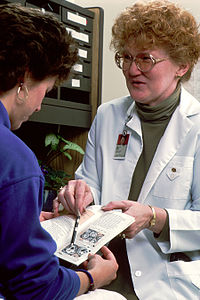
Photo from wikipedia
Objective To assess the impact of a 15-month, in-practice communication skills intervention on client visit satisfaction. Sample 4 purposely selected veterinary clinics, 9 veterinarians, and 930 appointment-specific client satisfaction surveys.… Click to show full abstract
Objective To assess the impact of a 15-month, in-practice communication skills intervention on client visit satisfaction. Sample 4 purposely selected veterinary clinics, 9 veterinarians, and 930 appointment-specific client satisfaction surveys. Procedures The study was designed as a multipractice, preintervention-postintervention study. Practice teams participated in a 15-month communication skills intervention that included interactive group workshops and one-on-one communication coaching with the entire practice. Client Satisfaction Questionnaires were completed 3 months before (mean, 55 questionnaires/veterinarian) and after (mean, 48 questionnaires/veterinarian) the intervention. The impact of the intervention and factors associated with client visit satisfaction were evaluated with mixed logistic regression. Results Client satisfaction scores were dichotomized owing to extreme negative skewness. In total, 57% (284/496) of clients were completely satisfied on pretest questionnaires, and 67% (290/434) were completely satisfied on postintervention questionnaires. The odds of clients being completely satisfied were significantly higher after the communication skills intervention (OR = 1.56; P = .002). When controlling for the intervention, predictors of client visit satisfaction included appointment type (odds of being completely satisfied were significantly higher for recheck appointments than for preventative care appointments [OR = 1.71; P = .02] and health problem appointments [OR = 1.99; P = .003]) and duration of the veterinarian-client relationship (probability increased by 0.52 with each 1-year increase in relationship duration; P = .008). Clinical Relevance Results suggested that the client-centered, skills-based communication intervention resulted in increased client visit satisfaction. Findings contribute to current evidence that client-centered communication and duration of the veterinarian-client relationship promote client satisfaction during veterinary visits.
Journal Title: Journal of the American Veterinary Medical Association
Year Published: 2022
Link to full text (if available)
Share on Social Media: Sign Up to like & get
recommendations!